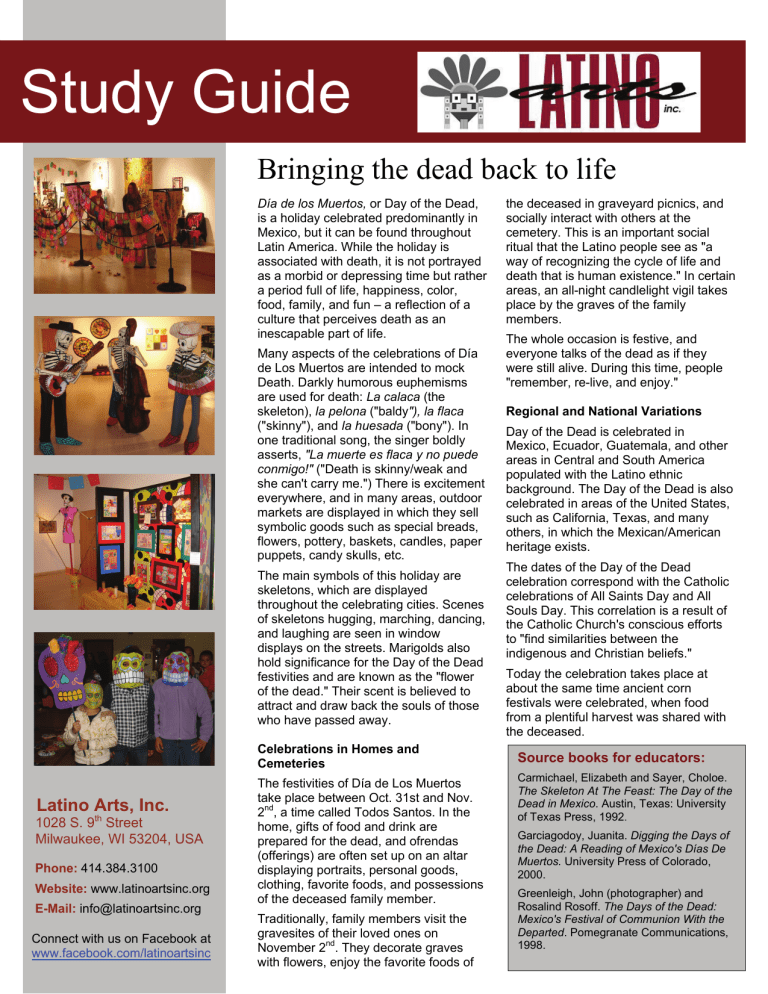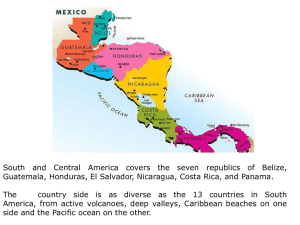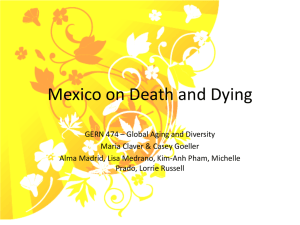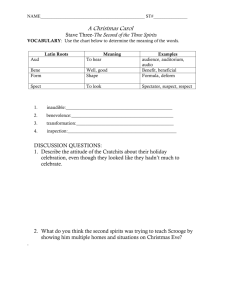Study Guide - Latino Arts, Inc.

Study Guide
Bringing the dead back to life
Latino Arts, Inc.
1028 S. 9 th Street
Milwaukee, WI 53204, USA
Phone: 414.384.3100
Website: www.latinoartsinc.org
E-Mail: info@latinoartsinc.org
Connect with us on Facebook at www.facebook.com/latinoartsinc
Día de los Muertos, or Day of the Dead, is a holiday celebrated predominantly in
Mexico, but it can be found throughout
Latin America. While the holiday is associated with death, it is not portrayed as a morbid or depressing time but rather a period full of life, happiness, color, food, family, and fun – a reflection of a culture that perceives death as an inescapable part of life.
Many aspects of the celebrations of Día de Los Muertos are intended to mock
Death. Darkly humorous euphemisms are used for death: La calaca (the skeleton), la pelona ("baldy "), la flaca
("skinny"), and la huesada ("bony"). In one traditional song, the singer boldly asserts, "La muerte es flaca y no puede conmigo!" ("Death is skinny/weak and she can't carry me.") There is excitement everywhere, and in many areas, outdoor markets are displayed in which they sell symbolic goods such as special breads, flowers, pottery, baskets, candles, paper puppets, candy skulls, etc.
The main symbols of this holiday are skeletons, which are displayed throughout the celebrating cities. Scenes of skeletons hugging, marching, dancing, and laughing are seen in window displays on the streets. Marigolds also hold significance for the Day of the Dead festivities and are known as the "flower of the dead." Their scent is believed to attract and draw back the souls of those who have passed away.
Celebrations in Homes and
Cemeteries
The festivities of Día de Los Muertos take place between Oct. 31st and Nov.
2 nd
, a time called Todos Santos. In the home, gifts of food and drink are prepared for the dead, and ofrendas
(offerings) are often set up on an altar displaying portraits, personal goods, clothing, favorite foods, and possessions of the deceased family member.
Traditionally, family members visit the gravesites of their loved ones on
November 2 nd . They decorate graves with flowers, enjoy the favorite foods of the deceased in graveyard picnics, and socially interact with others at the cemetery. This is an important social ritual that the Latino people see as "a way of recognizing the cycle of life and death that is human existence." In certain areas, an all-night candlelight vigil takes place by the graves of the family members.
The whole occasion is festive, and everyone talks of the dead as if they were still alive. During this time, people
"remember, re-live, and enjoy."
Regional and National Variations
Day of the Dead is celebrated in
Mexico, Ecuador, Guatemala, and other areas in Central and South America populated with the Latino ethnic background. The Day of the Dead is also celebrated in areas of the United States, such as California, Texas, and many others, in which the Mexican/American heritage exists.
The dates of the Day of the Dead celebration correspond with the Catholic celebrations of All Saints Day and All
Souls Day. This correlation is a result of the Catholic Church's conscious efforts to "find similarities between the indigenous and Christian beliefs."
Today the celebration takes place at about the same time ancient corn festivals were celebrated, when food from a plentiful harvest was shared with the deceased.
Source books for educators:
Carmichael, Elizabeth and Sayer, Choloe.
The Skeleton At The Feast: The Day of the
Dead in Mexico . Austin, Texas: University of Texas Press, 1992 .
Garciagodoy, Juanita. Digging the Days of the Dead: A Reading of Mexico's Días De
Muertos. University Press of Colorado,
2000.
Greenleigh, John (photographer) and
Rosalind Rosoff. The Days of the Dead:
Mexico's Festival of Communion With the
Departed . Pomegranate Communications,
1998.
Study Guide
PAGE 2 OF 4
Offerings and Celebration
Observances and Customs in
Mexico
In Mexico, this festival is considered to be the most important holiday of the year. A customary holiday food that is eaten is pan de los muertos ("bread of
The Day of the Dead is an important cultural event rich in religious context
(emphasizing the actual worship of the dead) and a unique Mexican holiday symbolized by special foods and candy. In Mexico, more urban areas treat the day with less religious and cultural importance, while more rural the dead"), which is flat bread baked in the shape of skulls and crossbones. It is said to be good luck to be the one who bites into the plastic toy skeleton hidden by the baker in each loaf. Customarily, people indulge in candy in the shape of skulls, skeletons, and coffins, and many favorite Mexican dishes (tamales, moles, and "Indian" settings treasure the religious importance of the holiday. For this reason, the
Elements of a Day of the Dead Altar
Photographs to help families remember the deceased
Personal mementos to be recognized by the visiting spirits and make them feel welcome
Paper cutouts (papel picado) in skeleton or floral designs
Candles one for each soul being remembered plus an extra flame for the forgotten soul
Icons, saint statues or crucifixes to serve as religious focal points for the display
Incense/copal to help the spirits find their way to the altar
Marigolds are a symbol of death dating back to Aztec times; their scent is said to attract the spirits
Food and drink to satisfy the hungry and thirsty souls who come to visit
Skeletons and skulls in many forms, including actual bones, folk art figurines, and elaborately decorated sugar skulls chiles, enchiladas) as part of the celebration.
This holiday is believed to "welcome the souls of the dead." The souls are said to return each year to enjoy the pleasures that they once had in life. They are thought to return to be with their living relatives for a few brief hours each year in this world, but they come as spirits who have returned from another world.
A widely held belief is that the souls of the children (called "angelitos") return on
November 1 st ; taste- and age-appropriate food and gifts are set out for them in a smaller scale: cups, plates, breads, etc.
The adult dead are said to return on the
2 nd , and they are offered the most elaborate foods and drinks the family can afford. It is believed that the candlelight, as well as the scents of marigold flowers and copal incense, help the returning souls find their way back.
Sometimes paths of marigold petals are scattered by the family from the cemetery to the door of the house. The ghosts (or spirits) are said to find their way by following this yellow path, and though they are not usually seen, their presence is felt. Many folktales say that the dead spirits will get revenge on the living if they treated poorly during these days each year. Leaving nothing (or inferior gifts) on the altar will anger or sadden the spirits. These tales inspire many people celebration is usually of greater social importance in southern Mexico than in the northern part of the country.
Additional Resources
Books for young readers:
Ancona, George. Pablo Remembers.
HarperCollins, 1993 (Ages 4-8).
Hoyt-Goldsmith, Diane and Laurence
Migdale. Day of the Dead: A Mexican-
American Celebration. Holiday House,
1994 (Ages 9-12).
Johnston, Tony. The Day of the Dead.
Voyager Books, 2000. (Ages 4-8).
San Vicente, Luis . Festival of the
Bones / El Festival de las Calaveras :
The Book for the Day of the Dead (bilingual). Cinco
Puntos Press, 2002 (Ages 4-8).
Web Resources:
Making Sugar Skulls: http://www.mexicansugarskull.com/mexican sugarskull/recipe.htm
Background on traditional and modern day Día de Los Muertos Celebrations: to participate in the holiday celebration to avoid upsetting the spirits.
http://www.houstonculture.org/mexico/main.
html
Study Guide
PAGE 3 OF 4
PAGE 3 OF 4
“Calavera” Songs and Rhymes
Taking their name from the word for “skull”, Calaveras are satirical or humorous verses that mock death, or praise or criticize important or recognized political, intellectual or celebrity figures.
Ahi viene el agua Here comes the water por la ladera, y se me moja mi calavera. down the slope and my skull is getting wet.
La muerte calaca, Death, a skeleton ni gorda ni flaca. neither fat nor skinny.
La muerte casera, A homemade skeleton pegada con cera. stuck together with wax.
“Ofrenda”, a mural by
Diego Rivera (1923)
The great Mexican poet, Octavio
Paz, described his culture’s perspective on death:
"The word death is not spoken aloud in New York, in Paris, in
London, because it burns the lips. The Mexican, in contrast, is familiar with death, chases after it, mocks it, courts it, hugs it, sleeps with it; it is his favorite toy and his most lasting love."
Where has your beauty gone?
Where is the brightness of your eyes?
Now I see only two holes,
Your large teeth,
An incomplete nose.
Death went and sat down one day,
Sat down in a sandy place,
And ate lots of cold tortillas
Just to try and gain some weight.
“La Catrina (Female Dandy)” by
José Guadelupe Posada (1851-
1913). Posada’s prints of skeletons famously applied political and social commentary to traditional Day of the Dead imagery.
The Calavera Oaxaqueña
The valiant calavera
Has just arrived today.
Take off your hat and greet him.
Don't look at him that way!
In Oaxaca they pay for bravery
With a hooter of mezcal.
And without a single rival
Are their beautiful young gals.
No one ever scares me.
At them all I do is guffaw.
And to prove this I danced a two-step
Upon a dandy from Guadalajar’.
The Oaxaca calavera
Has just arrived today.
Take off your hat and greet him
Because he's here to stay.
Class Projects
Study Guide
PAGE 4 OF 4
A painting that was part of an altar from Latino Arts’ 2006
Ofrendas Exhibit.
Marigold flowerpots bring color to the annual celebration of life.
PAN DE MUERTOS/ DAY OF THE DEAD BREAD
Here’s a fun exercise in “edible art” (provided you have access to an oven). A traditional food eaten during the holiday, pan de muertos , is also a common element on Day of the
Dead altars throughout Mexico. It can be molded into appropriate shapes like skulls, bones, angels, and animals.
Ingredients
• 1 ½ cups of flour
• ½ cup sugar
• 1 teaspoon of salt
• 1 tablespoon of anise seed
• 2 packets of dry yeast
• ½ cup of milk
• ½ cup of water
• ½ cup of butter
• 4
•
3 to 4 ½ cups of flour
Preparation
1. Mix together all dry ingredients except the flour.
2. In a small pan, mix and heat the milk, water, and butter. Add this liquid to your dry mixture.
3. Beat
4. Mix in the eggs and 1½ cups of flour and beat well.
5. Add the remaining flour in small increments.
6. Knead the mixture on a floured board for 9-10 minutes.
7. Put the dough in a greased bowl and allow it to rise until it has doubled in size (about
90 minutes).
8. Punch the dough down and reshape it with “bone shapes” to decorate the top.
9. Let it rise again for 60 minutes.
10. Bake at 350º F for 40 minutes.
11. After baking, color with powered and colored sugar, icing, candies, or paper cutouts.
MARIGOLD FLOWERPOT
In the marketplaces that crop up in Mexican towns during the Day of the Dead, the bright colors of masses of marigolds dominate the scene. Cempazuchi , as the ancient
•
Aztecs named them, are placed on graves and incorporated into altars as a way to welcome the spirits of the deceased.
Materials
• 4” clay flowerpots
• Acrylic paints and brushes
• Clear acrylic spray varnish
• Packets of marigold seeds (dwarf varieties will work best for this project)
Potting soil
Instructions
1. Using books from the suggested list, or from sites on the internet, find imagery, symbols, and motifs that are part of Day of the Dead celebrations. A popular subject is skeletons portrayed in the style of Posada – dancing, dressed up, riding bicycles, playing instruments, etc.
2. Have the students incorporate these designs as they paint their flowerpots.
3. After allowing the paint to dry, spray inside and out with the clear finish and allow to dry completely .
4. Fill the pot with dampened soil, then plant 4-5 seeds per pot, ½ inch deep. Place the pots on a sunny windowsill, water regularly, and you’ll have flowers in 40 to 50 days.




